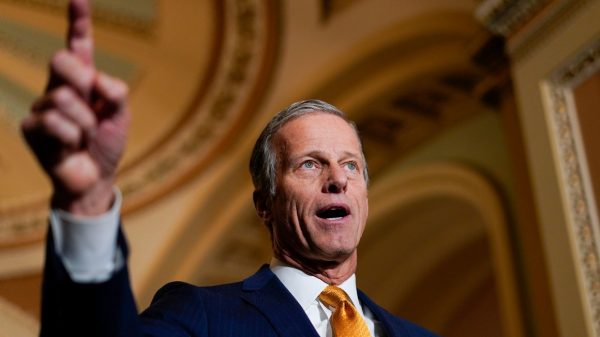The world is headed for a low-carbon transition whether Canada is ready or not — and if companies and government policies don’t get better prepared for this shift, 800,000 jobs could be on the line.
That’s the latest finding from the Canadian Institute for Climate Choices (CICC)’s report, Sink or Swim, Transforming Canada’s economy for a global low-carbon future, which was released Thursday morning.
Read more:
Climate change is ‘biggest health threat facing humanity,’ WHO says
To avoid a massive drop in profits for Canada’s publicly traded companies — and to help save the 800,000 jobs that exist in these transition-vulnerable sectors, like auto manufacturing and oil — the researchers warn that governments and companies alike need to act fast.
“If those companies are successful in adapting to new market realities, then they can be successful for the coming decades,” said Rachel Samson, who is the Clean Growth Research Director at the CICC.
“However, if they’re not, there is a risk of job loss, and it’ll be important for communities and regions to consider opportunities for developing new areas of growth.”

More than 60 countries representing at least 70 per cent of the global GDP have committed to reaching net-zero emissions by 2050. Global investors are also starting to recognize the importance of climate action. Technological change around the world is accelerating, too, according to the report.
These three factors tell a story: low-carbon transition is happening, the report says, and fast — and Canada has to keep up.
“Three broad trends are combining in ways that make the global low carbon transition inevitable. And in some markets, change may happen much more quickly than anticipated,” said Samson.
“Our results show that Canadian exporters and multinationals are not yet ready for a global transition.”
The report laid out four recommendations that governments and companies can take on to ensure Canada is prepared to weather the looming global transition to a low-carbon economy.
The first recommendation is to immediately prioritize “forward-looking decision making.”
Policymakers should consider the “future competitive benefits” of policies that improve the country’s readiness for the low-carbon transition of companies, Samson said, and ensure those policies generate demand for products with growth potential. For example, creating a zero-emissions vehicle mandate that requires all cars purchased after a certain year to be electric. This kind of policy creates a demand for an industry that auto manufacturers can pivot towards, the report suggests.
Read more:
‘Code red for humanity’: Climate change spiraling out of control, U.N. report says
The second recommendation is to “rebalance public investments and tax incentives to mobilize private investment in future fit projects and companies,” Samson explained. In practice, she said, this means fewer subsidies for fossil fuel companies and more for industries that are expected to see strong growth in demand going forward — like hydrogen, renewable energy and biofuels.
Communities also need to get their hands dirty when it comes to decreasing the disruption of a low-carbon transition, according to the CICC.

The third recommendation is to develop local and people-focused transition plans. In other words, businesses need to attract new sources of growth and jobs to a community that might be reliant on a transition-vulnerable industry. For example, when the GM plant in Ingersoll, Ont., invested $1 billion to covert the site into Canada’s first large-scale commercial electric vehicle manufacturing plant
These companies also need to increase flexibility within the local workforce through education and skills training.
Finally, the report recommends that governments disclose “decision-useful climate metrics,” Samson said, which could help to clarify rules on climate-related financial products.
While these recommendations might seem like a tall order, John Stackhouse, senior vice-president in the office of the CEO at Royal Bank, says the transition to a low-carbon economy is “entirely feasible.”
“It is the biggest challenge we have known as a country – certainly the biggest challenge many of us, or any of us, have seen in our lifetime,” he acknowledged.
While doable, a new report released by RBC Economics, analyzed by Stackhouse and his team, shows the change will come at a cost.
“As with so many big challenges in life, the best way to go about them is to break it down into manageable pieces,” he said.
Canada will need roughly $2 trillion to put the economy on a path to net-zero emissions in 30 years. The RBC report estimates governments, businesses and communities would have to spend at least $60 billion annually to cut emissions by 75 per cent of current levels and reach the 2050 target of net zero.
Money will be needed to build out the electricity system to handle the expected rise in electric vehicles, too, and investment will be required in retrofitting old buildings faster than current federal plans predict. Skills training will also be a big part of the equation, the RBC report found.
“The biggest challenge is not the entirety of this net-zero project for the country. The biggest challenge, as with any journey, is getting going with it, taking those first hard steps, which we’ve done as a country,” Stackhouse said.
“We’re not starting from scratch here, but we’ve got to take more of those early steps … not spend year after year debating, analyzing, wondering.”
‘This transition is coming’
Taking these steps will help to ensure Canada is on good footing as it navigates the potentially bumpy transition, according to the CICC.
“This transition is coming irrespective of decisions in Ottawa, or even decisions at provincial levels. This transition is coming from factors outside of Canada’s control,” said Dale Beugin, research and analysis vice president at the CICC.
“So really, it’s all about what the country … at all orders of government, can do to prepare ourselves for that shift that is making its way to our shores no matter what.”
Read more:
Google moves to demonetize and ban ads on climate denial content
There’s still time for Canadian companies to get involved in this transition, according to Blake Shaffer, a Calgary-based economist. Shaffer doesn’t believe this change among industries will happen overnight.
“The question is, where is growth going to go? Most credible studies are now showing that we’re really near the peak of any demand (for fossil fuels), and it’s slowly going to wane over the years to come,” said Shaffer, who is also working with the CICC as a technical advisor for their forthcoming project on net-zero electricity systems.
He said that if Alberta and other parts of Canada continue to invest in the industries that will slowly decline, they run the risk of “having a lot of stranded assets.”

Shaffer added that he’s seen a shift among Alberta energy CEOs and Alberta residents in recent years — including an “acceptance” of “the language of energy transition” as well as a “real desire” to play a role in this shift.
“Whether that’s motivated because people have real environmental goals or if they simply see profitable opportunities, I don’t know, but they’re doing it nonetheless,” he said.
“To me, that’s a really good thing — people seeing opportunities and wanting to be a part of it for a variety of reasons.”
–With files from The Canadian Press
© 2021 Global News, a division of Corus Entertainment Inc.














































